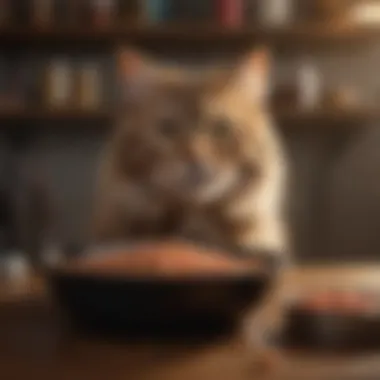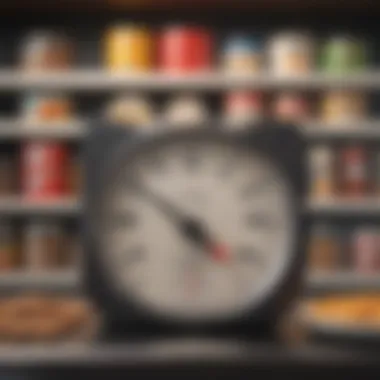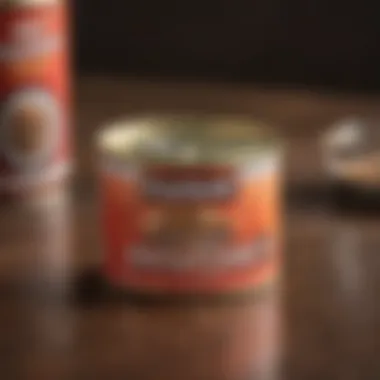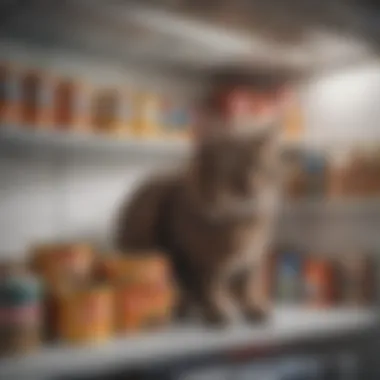Understanding Wet Cat Food Shelf Life and Safety


Intro
With the increasing prevalence of wet cat food in pet owners' kitchens, understanding how to safely serve and store it has become paramount. Wet cat food provides cats with vital hydration and essential nutrients, but improper handling can lead to food safety issues. This article will explore critical factors influencing the longevity of wet cat food, while offering practical tips for serving and storage. By integrating knowledge about bacterial growth, environmental effects, and the best practices for handling, pet owners can ensure their cats consume safe and nutritious meals while minimizing waste.
Pet Care Essentials
Importance of Balanced Nutrition
Diet plays a crucial role in a cat's health. Wet cat foods are generally rich in protein and moisture, helping to keep cats hydrated. However, it's essential for pet owners to pay attention to the nutritional content in relation to their cat's specific needs. Cats require certain elements, such as taurine and arachidonic acid, which may not be present in adequate amounts in low-quality products.
Best Serving Practices
To prevent spoilage and waste, following appropriate serving practices is vital. Always check the food’s expiration date before serving. According to the recommendations from various veterinarians, wet cat food should be served in appropriate portions suited for your cat's eating habits.
When serving, consider the following tips to ensure freshness:
- Minimize Visitation: Offer food in the pet's designated meal times to avoid leaving it out too long.
- Room Temperature: Warm up straight from the fridge as cold food can discourage consumption.
- Use Clean Utensils: Each meal should use a clean bowl to reduce contamination risks.
Storing Leftovers
After a meal, it is necessary to store any leftover wet food correctly. An open can of common brands like Friskies or Fancy Feast should be covered and refrigerated. Remember to consume leftover food within two to three days to avoid spoilage.
"Keeping wet cat food consumed within appropriate time limits can significantly reduce the risk of bacterial growth and ensures that your pet remains healthy and happy."
Key Takeaway
Pet owners must be informed about the balance between nutrition and food safety. Making sure that wet cat food is handled, served, and stored properly is essential for every cat's well-being.
Intro to Wet Cat Food
Wet cat food plays an essential role in the diet of many felines. Understanding its significance is crucial for responsible pet owners. This section will delve into the importance of wet cat food, emphasizing not only its nutritional contributions but also the considerations that come with feeding it to pets.
Wet cat food offers various benefits that enhance a cat's health and well-being. It typically contains higher moisture content compared to dry food, which is vital for maintaining proper hydration. Cats are often less inclined to drink water, making wet food a beneficial option for promoting fluid intake. Furthermore, many cats find the texture and flavor of wet food more appealing, which can help in stimulating their appetites, particularly in seniors or those recovering from illness.
However, feeding wet cat food requires careful consideration. The proper management of its shelf life is vital to prevent spoilage and foodborne illness. Owners should be informed about how to store these products effectively and the signs of spoilage to look for. By equipping themselves with this knowledge, owners can ensure their cats enjoy safe and nutritious meals.
Nutritional Value of Wet Cat Food
The nutritional value of wet cat food varies significantly based on the ingredients used and the manufacturing process. Most formulations contain a balance of proteins, fats, vitamins, and minerals essential for a cat's diet. Cats are obligate carnivores, which means their diet must be rich in animal-based proteins. Wet cat food often lists real meat as the first ingredient, thereby providing the necessary protein content.
In addition, wet food can be an excellent source of healthy fats, which are crucial for energy and promoting a healthy coat. The blend of vitamins and minerals, such as Vitamin E, taurine, and omega fatty acids, supports various bodily functions, including vision, immune response, and overall health.
It is advisable for pet owners to consult ingredient labels and nutritional profiles to ensure they choose high-quality wet food tailored to their cat's specific needs. This can help in making informed decisions about their pets' diets.
Wet Food vs. Dry Food
When considering wet food versus dry food, several factors come into play. Each type has its advantages and disadvantages, which are important for pet owners to consider when planning their cat's diet.
Wet cat food, as mentioned earlier, has a higher moisture content. This quality contributes to hydration, which is essential for preventing urinary tract issues, a common concern among felines. Moreover, wet food is often perceived as more palatable, leading to increased consumption among picky eaters.
On the other hand, dry cat food offers convenience and cost-effectiveness. It has a longer shelf life and can be left out without the same concerns of spoilage that wet food has. Many owners appreciate the ease of measuring dry food portions without worrying about immediate spoilage.
However, pet owners must weigh these factors carefully. Transitioning between the two types requires monitoring how cats respond to changes in their diet and adjusting accordingly. A mixed feeding approach may also suit some pets, combining the advantages of both wet and dry food. It is essential to ensure that whatever feeding method is chosen, the nutritional needs of the cat are met comprehensively.
Factors Affecting Shelf Life of Wet Cat Food


Understanding the shelf life of wet cat food is essential for pet owners. Several factors can significantly influence how long this type of food remains safe for consumption. This knowledge helps in ensuring a cat eats safely and maintains good health. Moreover, understanding these elements can assist in minimizing waste, which is a practical concern for many cat owners.
Bacterial Growth
Bacterial contamination is a primary concern when discussing the shelf life of wet cat food. It can occur due to improper storage or exposure to unsanitary conditions. Understanding the types of bacteria that can thrive in wet cat food is critical for pet owners.
Common Bacteria in Pet Food
Pet food can sometimes harbor bacteria like Salmonella and E. coli. These bacteria are known for their potential to cause serious health issues. Salmonella can lead to gastrointestinal problems in both cats and humans. Cats infected may show symptoms like vomiting or diarrhea.
E. coli is another pathogen that is notable for its rapid growth in wet environments. This bacteria can double its population within hours, increasing the risk of contamination significantly. Pet owners need to be vigilant because feeding their cat improperly stored wet food can expose both their pets and themselves to these harmful bacteria.
How Bacteria Multiply
Bacteria multiply through a process called binary fission. This means one bacterial cell divides into two, and this process can repeat rapidly under optimal conditions. Growth rates depend on several factors, including temperature and food availability. When wet cat food is left out at room temperature, the likelihood of bacterial proliferation increases.
The key aspect here is time; the longer the food sits out, the greater the chance for bacteria to multiply. Understanding this characteristic of bacteria is vital. Pet owners should be aware that feeding their cats food that has been out too long can pose a health risk.
Environmental Conditions
Environmental conditions also play a significant role in determining the shelf life of wet cat food. Factors such as temperature and humidity can enhance or hinder the safety and quality of the food.
Temperature Influence
Temperature significantly affects how long wet cat food remains safe. High temperatures can accelerate spoilage, while cooler temperatures can extend its usable life. When wet cat food is exposed to heat, nutrients can break down, and bacteria thrive. Therefore, it is important to store wet food in a cool area and to serve only what will be eaten within a reasonable time.
Moreover, maintaining an appropriate temperature is crucial in preventing foodborne illnesses in cats. This detail is quite relevant for cat owners.
Humidity Impact
Humidity is another environmental factor affecting wet cat food. Higher humidity levels can lead to spoilage faster. Moisture in the air can enter the food packaging and create a breeding ground for bacteria and mold.
For this reason, it is best to store wet cat food in an area with low humidity. If pet food is stored where moisture is present, it may not last as long. This can create issues not only of spoilage but also of palatability for the cat.
By understanding both bacterial growth and environmental conditions, pet owners can make better decisions about storing and serving wet cat food. This knowledge creates an informed approach to feeding practices, minimizing risks and ensuring the health of their cats.
Manufacturer Recommendations
Understanding the manufacturer recommendations regarding wet cat food is essential for ensuring your pet's safety and well-being. These guidelines provide crucial information that can assist you in making informed decisions about your cat's diet. Manufacturers invest time and resources into research aimed at enhancing pet nutrition and safety. Therefore, their recommendations often reflect the latest scientific findings in pet care.
Adhering to these guidelines is not merely a suggestion; it can significantly impact your cat's health. Each brand has specific instructions that consider various factors such as ingredients, preparation methods, and storage protocols. By following these recommendations, pet owners can help mitigate the risks associated with bacteria growth and spoilage, keeping their furry friends safe from potential health threats.
Additionally, manufacturers typically address how their products should be served and stored after opening. This information helps minimize food waste and ensures that every meal can be as nutritious as intended. In the next subsections, we will delve deeper into the typical guidelines provided by various brands and the importance of expiration dates.
Typical Guidelines from Brands
Different brands will set forth their own unique guidelines for the use and storage of wet cat food. For instance, most brands will recommend that you serve the food at room temperature. This enhances palatability for your pet. Furthermore, many brands suggest that any opened cans of wet food should be refrigerated and used within 2-3 days to maintain freshness.
Here are a few common guidelines to follow:
- Refrigeration: Store uneaten food in an airtight container in the refrigerator to prevent bacterial growth.
- Serving Size: Follow the recommended serving sizes based on your cat's weight and activity level. It helps in managing portion control effectively.
- Feeding Schedule: Try to establish a regular feeding schedule, as routine can help your cat's digestive system.
Expiration Dates and Their Importance
Expiration dates are integral to ensuring the safety and quality of wet cat food. These dates indicate the timeframe within which the food is expected to retain its nutritional value and safety. Consuming products past their expiration can lead to health risks, including foodborne illnesses.


It is essential to check expiration dates before purchasing. Once opened, the viability of wet cat food diminishes, so keep an eye on the date as well as the condition of the food. If a can is not consumed promptly after opening, it should not be kept beyond the manufacturer’s recommendation.
"Always trust the expiration dates provided by manufacturers; they are based on extensive testing and food safety standards."
Understanding these elements leads to better health outcomes for your cat, less waste, and a more enjoyable feeding experience.
Practical Guidelines for Serving Wet Cat Food
Feeding wet cat food requires more than just opening a can and serving it to your pet. Understanding practical guidelines can help ensure that your cat's meals are safe, nutritious, and enjoyable. Proper serving techniques minimize waste and reduce health risks. Here, we delve into time limits for leaving food out and signs of spoilage.
Safe Time Limits for Leaving Food Out
FDA Recommendations
The FDA provides specific recommendations on how long wet cat food can remain at room temperature. Generally, it is suggested that open cans of wet cat food should not sit out for more than four hours. This timeframe helps limit the risk of bacterial contamination, which can occur rapidly in moist environments.
One main aspect of the FDA recommendations is their focus on ensuring pet safety. These guidelines reflect extensive research into foodborne pathogens. Following these recommendations is beneficial because it gives pet owners a straightforward time limit that is easy to remember.
A unique feature of the FDA guidelines is their emphasis on temperature. They suggest keeping the food in a cool area. Heat can accelerate spoilage, so this factor can be a crucial consideration for pet owners living in warmer climates.
Veterinary Insights
Veterinarians often echo FDA recommendations but also offer their insights based on everyday observations in clinical settings. Many vets advise that wet cat food should ideally be served fresh. While the FDA suggests four hours, some veterinarians recommend a more conservative approach such as two hours, especially in warmer weather.
What is significant about veterinary insights is that they are based on experience with numerous pets. They often see the consequences of spoiled food, which can lead to vomiting or more severe gastrointestinal issues. This experience contributes to a deeper understanding of risks.
Vets also highlight the importance of a pet's individual health. Cats with sensitive stomachs or compromised immune systems might need stricter adherence to these guidelines. Thus, the unique feature of veterinary insights is their tailored approach to individual pet needs, providing flexibility in handling different situations.
Signs of Spoilage
Recognizing signs of spoilage is essential for pet owners. Spoilage can compromise not just the taste but also the safety of the food.
Visual Indicators
Visual indicators of spoilage are important for pet owners to observe. The presence of mold or unusual discoloration are significant warning signs. Wet food should ideally have a consistent texture and color when it's fresh.
One key characteristic of visual indicators is that they are easy to identify. Most pet owners can immediately see when something is wrong, making this a beneficial method of inspection.
Moreover, the unique feature of visual indicators lies in their immediate clarity. Unlike other factors that may require deeper analysis, a visual check can be done quickly before serving the food.
Odor Changes
Another aspect to consider is odor changes. Fresh wet cat food should have a mild, appetizing scent. If the food develops a sour or rancid smell, it indicates spoilage.
The key characteristic of odor changes is that they often signal spoilage even before visual indicators become apparent. Many pet owners find this easy to notice, making it a practical way to assess the food.
Further, the unique nature of odor changes is that these are often subjective. Different individuals might perceive smells differently, which can be both an advantage and disadvantage. It's a good practice to establish a baseline smell for fresh cat food so that any deviations are easily identified.
"Regular inspections based on visual and olfactory indicators can prevent health risks and ensure a better feeding experience for your cat."
Implementing the above guidelines can help pet owners serve wet cat food safely while also promoting overall well-being for their pets. The combination of proper time limits and attention to spoilage signs creates an informed approach to feeding that benefits both animal and owner.
Best Practices for Feeding Wet Cat Food
Feeding wet cat food involves more than just opening a can and serving it. Best practices are integral for ensuring the food remains nutritious and safe for consumption. Proper techniques in portion control and storage can greatly affect the health of your cat. Adhering to these practices not only maintains the quality of the food but also minimizes waste and enhances the overall meal experience for your pet.


Portion Control
Portion control is a vital aspect of feline nutrition. Cats have specific dietary needs that may vary by age, weight, and activity level.
- Understanding Portions: Start by consulting the feeding guidelines provided on the wet food packaging. These guidelines offer a baseline to determine how much to serve based on your cat's weight and lifestyle.
- Avoid Overfeeding: It is easy to give more food than necessary, leading to obesity and related health issues. Monitoring your cat's weight consistently can help in adjusting portion sizes appropriately.
- Frequent Smaller Meals: Serving smaller portions more frequently can be beneficial. Cats, as natural hunters, often prefer to eat multiple small meals throughout the day rather than one or two large ones.
Proper Storage Techniques
After Opening
Once a can of wet cat food is opened, the storage methods you choose significantly impact its longevity. An opened can of wet cat food should be stored correctly to minimize spoilage.
- Refrigeration: Store any uneaten portion in the refrigerator, which helps slow bacterial growth significantly. Ideally, place it in an airtight container or cover it tightly with plastic wrap.
- Shelf Life: Generally, opened wet food should be consumed within three to five days. After this time, the quality diminishes, even when stored in a cool environment.
- Temperature Awareness: Ensure the food is always kept at a safe temperature. Leaving opened food at room temperature can lead to quicker spoilage.
Sealed Containers
Utilizing sealed containers enhances the preservation of wet cat food once opened. This method provides a secure environment, shielding the food from external pollutants and odors.
- Advantages of Sealing: Sealed containers prevent air exposure, which can cause oxidation and loss of nutrients. By using airtight storage, you can effectively extend the freshness of the food beyond typical refrigeration methods.
- Ease of Use: Sealed containers are often easier to handle compared to covers for cans. They can make it simpler to serve food without making a mess.
- Size Matters: Choose the appropriate size for your storage needs. A container that is too large may trap air inside, defeating the purpose, while one that is too small may not hold all leftover food securely.
It is important to remember that proper feeding and storage techniques contribute to better health for your cat, reducing the risk of spoilage and waste.
When to Discard Leftover Wet Cat Food
Discarding leftover wet cat food is an essential routine for pet owners. Failure to do so can lead to health risks for the cat. Therefore, understanding when to discard uneaten food can prevent sickness and ensure your pet receives optimal nutrition.
Assessing Leftover Viability
To assess whether leftover wet cat food is still safe to feed to your cat, consider several key factors. First, look at the time it has been left out. The general guideline suggests that wet cat food should not be left out for more than four hours at room temperature. After this period, the risk of bacterial growth significantly increases.
Additionally, consider visual cues. If the food has changed color, or if you see any mold or unusual textures, it is better to discard it. Smell is also a critical indicator. Spoiled food may emit a foul odor. Always perform a quick check before serving leftovers again.
Health Risks of Spoiled Food
Serving spoiled wet cat food poses various health dangers. Common bacterial pathogens, such as Salmonella and E. coli, can thrive in decomposed food. These bacteria can cause gastrointestinal upset in cats, leading to symptoms like vomiting, diarrhea, and lethargy.
This risk is not just theoretical. According to the Center for Disease Control and Prevention, pets can become infected and can then pass those bacteria to humans, leading to further health concerns.
"Proper food handling is an essential practice in pet care. Ensuring food safety not only protects your cat but also your family."
In summary, health risks associated with spoiled food make vigilance a priority for pet owners. Regularly check for spoilage and adhere to recommended time limits. This not only promotes your cat's well-being but also fosters healthy feeding practices in your household.
Ending
The conclusion of this article encompasses the critical components that have been discussed regarding the shelf life of wet cat food. It emphasizes that understanding the duration for which wet cat food can safely be left out is not just a matter of convenience, but a crucial aspect of ensuring the health and well-being of our feline companions. Pet owners need to recognize the implications of bacterial growth, the influence of environmental conditions, and the best practices for serving wet cat food.
The importance of adhering to manufacturer recommendations cannot be overstated. These guidelines are formulated based on extensive research and are designed to help pet owners avoid potential health risks associated with spoiled food. Moreover, the article provides insight into assessing leftover viability and recognizing signs of spoilage, which are essential for maintaining the nutritional integrity of the food.
By incorporating the recommended practices into daily routines, pet owners can contribute to their cats' overall health. Ultimately, being diligent in these measures not only enhances meal safety but also minimizes waste, as understanding the proper storage and serving methods directly correlates to better resource management and care for our pets.
Summary of Key Points
- Shelf Life Knowledge: Understanding the shelf life extends beyond expiration dates, involving various factors that affect food safety.
- Bacterial Growth: Awareness of common bacteria and conditions promoting their growth is essential for safe feeding practices.
- Manufacturer Guidelines: Always refer to recommendations from food manufacturers regarding storage and consumption.
- Signs of Spoilage: Visual and olfactory indicators can help determine if food is still safe for cat consumption.
- Practical Practices: Implementing effective portion control and storage techniques helps maintain the quality of wet cat food.
Final Recommendations for Pet Owners
- Follow Expiration Dates: Always check the expiration date and adhere to it closely.
- Inspect Food Regularly: Evaluate both opened and unopened cans for any signs of damage or spoilage before serving.
- Limit Serving Times: Be mindful of how long food is left out, adhering to FDA recommendations for safe consumption windows.
- Prioritize Storage: Store opened cans properly in the refrigerator, ideally using airtight containers, to lessen risks.
- Consult Professionals: If in doubt, don’t hesitate to consult with a veterinarian regarding feeding practices and storage to ensure optimal health for your cat.
"Proper feeding practices are a cornerstone of responsible pet ownership."
By integrating these practices, pet owners will ensure that feeding wet cat food is a safe, nutritious, and effective way of managing their pet's dietary needs.







